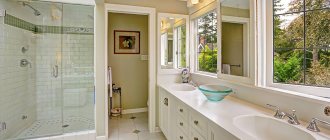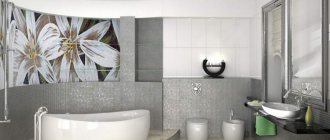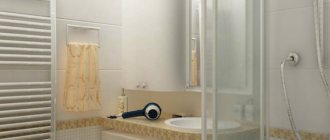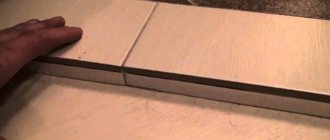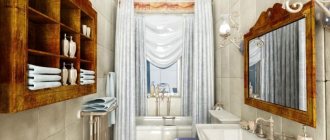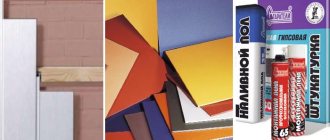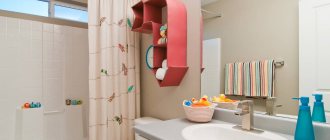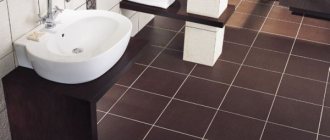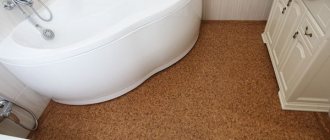Porcelain tiles and tiles, similarities and differences
There is an opinion that porcelain stoneware differs from tiles in the presence of natural stone particles. This is a common misconception. The composition of these finishing materials is identical. It includes:
- purified clay suspension;
- kaolin clay;
- feldspar;
- quartz sand;
- coloring natural pigments.
Porcelain tiles contain particles of natural stone
The differences in the technological characteristics of these materials are ensured by the specifics of the production process. Porcelain stoneware blanks are pressed with increased pressure of about 500 kg/sq.cm and processed at high temperatures of 1300 degrees.
Porcelain tiles are ideal as bathroom tiles, since high pressure and temperature lead to the melting of the clay, forming a monolithic structure. There are no pores in this material, like in tiles, moisture cannot penetrate into it. This prevents destruction of the structure.
Porcelain tiles make it easy to create an attractive design.
Many people are attracted to glazed tiles, which have high aesthetic qualities. But by purchasing porcelain tiles for your bathroom, you can create an equally attractive design. Moreover, the decor of this coating will last longer, since the coloring substances are not in the glaze, but in the composition of the tile.
Advantages of porcelain tiles
This coating has a number of advantages that make it a leader among other types of bathroom tiles:
- Porcelain tiles have good density and do not contain voids, inclusions or microcracks. This quality provides good bending strength of the material, which allows it to be laid on a not too flat surface. Also, due to its high density, such a coating can withstand a load of 300–400 kg.
- The tile is resistant to various damages, scratches or chips.
- The coating is moisture-resistant, which extends its service life for years. Thanks to this quality, porcelain tiles are not prone to staining. And the structure of the tile does not allow harmful microorganisms to penetrate into the coating.
- Non-flammability of the coating: if a fire occurs, it will not only not catch fire, but will also stop the spread of fire.
- Porcelain tile coating does not conduct electric current, ensuring safety for humans. This coating is especially important when installing an electrical “warm floor” system, which is common in bathrooms today.
- Eco-friendly coating. This material is made from natural raw materials. Plus, everything else, it is devoid of radioactivity, which simple granite has.
- Porcelain tiles are colored throughout their entire thickness. This advantage affects the external qualities of the coating: even after many years it does not change its original appearance.
- A large assortment of tiles, which are classified according to different criteria, allowing you to choose the most successful option.
Porcelain tiles for heated floors in the bathroom
Unique properties of porcelain stoneware
The absence of pores, the perfectly smooth surface of the material prevents the penetration of water into the structure. But not only this feature makes it advisable to use porcelain stoneware in the bathroom. Specific technological processing provides it with strength comparable to that of natural granite. These coatings:
- have maximum wear resistance;
- can be cleaned without fear of scratching the surface;
- do not become cracked during operation;
- inert to aggressive chemicals.
Material characteristics guarantee long service life
These technical characteristics guarantee long service life, ease of maintenance, and cleanliness. Photos of porcelain tiles for the bathroom allow you to appreciate the excellent aesthetic characteristics of the material. Its advantages include a large assortment, allowing you to make a good choice for any design.
Temperature changes are not dangerous for coatings; they retain their structure over a wide range. You can use porcelain stoneware for bathrooms, baths, saunas, and outdoor decorations.
Porcelain tiles have maximum wear resistance
What are they?
There are 2 main types of ceramic fonts.
Metal ceramics
This is the most common format for producing ceramic bathtubs. Initially, a metal base is made that completely follows the shape of the bowl. This frame is covered with a layer of clay and fired at temperatures of 800-1000 °C. Then the product is coated with enamel of any color. This production format is simpler compared to purely ceramic, but some authenticity and naturalness are lost.
Faience font
This option can rightfully be called a ceramic bathtub, because... consists entirely of this material. Such plumbing products are cast, as they are produced by casting a composition from clay and quartz into plaster molds specially made for this purpose: oval, angular, round.
The composition hardens for 10 days and is then removed from the mold. Next, it is dried in special dehydrators and subjected to high-temperature firing. This allows you to give the bowl strength.
After the font has gone through the drying procedure, it’s time to apply the enamel. A wide palette of colors is offered here, so the buyer can choose a coating to match the tone of his interior .
The price of such baths is very high and starts from 400,000 rubles. The reason for this is a very complex production technology. A small number of manufacturers produce such plumbing products - hence the low supply.
As for the installation of ceramic fonts , everything is simple. The only condition that must be met is a perfectly flat floor.
Bathtubs, as a rule, are freestanding and placed on legs or simply with the bottom of the bowl on the floor. Therefore, special requirements are placed on the level of evenness of the floor covering.
The main disadvantage of these fonts is their fragility . Despite the fact that the product goes through several stages of drying and firing, special strength cannot be achieved. An accidentally dropped heavy object can lead to irreversible consequences - a piece of the bathtub may simply break off. Therefore, you need to handle them very carefully, otherwise the cost of a mistake will be high.
It is also worth pointing out that earthenware cups have a lot of weight, which directly depends on the size and shape and
can reach 150 kg , so it is better to install such a bowl by two workers.
Types of coatings
Manufacturers offer consumers a wide range of these finishes, allowing you not to limit yourself in choice. It contains material:
- matte, polished, glazed;
- for covering floors and walls;
- standard and non-slip;
- in classic, modern design;
- plain and printed.
When choosing porcelain tiles for the wall in the bathroom, you can give preference to noble matte coatings, spectacular polished tiles, glazed material with original, multi-colored decor. These types of porcelain stoneware are not used for floor finishing, since the polished coating creates a risk of slipping and injury, and the glaze can wear off under such operating conditions.
Spectacular polished tiles
Special tiles designed for flooring have a non-slip texture. There are several processing technologies. In satin finishing, a pattern is created on blanks of mineral salt and fixed under the influence of high temperatures. Structuring allows you to create accurate imitations of wood, leather, stone, etc. In the photo of porcelain tile designs in the bathroom you can see many such options.
Porcelain tiles imitating wood
The range of this material includes tiles of different sizes. There are elements of medium size, large format, square, and complex configurations. You can purchase porcelain tiles for your bathroom, taking into account the size and layout features.
Choosing a finishing material: what needs to be taken into account?
But with all the positive qualities, there are also some disadvantages.
- Finishing a bathroom with porcelain tiles must be especially careful; the floor must be leveled without leaving any unevenness or air cushions, otherwise the lining will crack under your weight;
- The price of the material is much higher than that of ordinary ceramic tiles, but so is the quality. At the same time, the beauty of porcelain stoneware finishes cannot be compared with tiles; just look at the photos of the presented samples to see that this is true.
It’s especially good that you can choose a material that replicates the natural texture of natural materials. For example, wood-look porcelain tiles in the bathroom will look perfect, fill the room with the right energy and will last a long time. And in order not to make a mistake in choosing a material, just look at customer reviews of the product and purchase tiles that will meet your needs and capabilities.
The most popular porcelain tile
All types of this material are popular. There is a conditional rating that can help if you want to choose a fashionable, stylish finishing option. When choosing porcelain tiles for the bathroom wall or floor, pay attention to the materials:
- in neutral colors - white, gray, red, black;
- imitating wood, leather, stone;
- with original, unusual decor.
Neutral tones are used in both classic and modern styles. These coatings are ideal for visual correction and become an excellent backdrop for furniture and plumbing equipment. In the photo of porcelain tiles for the bathroom there are many options for combining colors. This technique is used to create unique interiors.
Neutral colors make a great backdrop for furniture
Nowadays, porcelain stoneware is in high demand as bathroom tiles, imitating various natural materials. You can choose the warmth and comfort of wood, the grandeur and elegance of stone, the solidity and chic of leather. These coverings provide an opportunity to give the environment a certain character, make it original and interesting.
Numerous photos of designs of porcelain tiles in the bathroom allow you to correctly select the material for a specific interior, ensure its harmony and compliance with fashion.
The elegance of stone for a modern interior
When purchasing this material, you must ensure the quality of the product. The main guarantor is the popularity of the manufacturer. But no one is immune from fraud. Before purchasing porcelain tiles for your bathroom, you should weigh the packaging. A discrepancy in mass may indicate technology violations. Pay attention to the reverse side. Technological recesses should not be more than 2x2 cm. Make sure that the shade of the batch tiles completely matches.
Porcelain tiles for the bathroom, design ideas
Palissandro collection (Vitra, Turkey-Russia)
Using porcelain tiles, you can recreate different ideas of modern design. The most popular types are those that create an imitation of natural stone, metal or leather.
Design options:
- Marbled. The play of shades, veins and other inclusions imitates stone as accurately as possible.
- White. Tiles polished to a shine visually expand the space, making the room more spacious and brighter.
- Red. A good option for flooring as part of a spectacular mosaic in combination with other colors.
- Grey. Gray, pearl or light-colored porcelain tiles are ideal for bathroom walls. This is one of three basic shades that can be combined with any other color.
- Black. Looks impressive in combination with white veins. Most often it is decorated in the bathroom in the Gothic style. For high-tech or technical style, the combination of white and black tiles looks beautiful.
Practical material can be found imitation Indian silk, concrete blocks, classic terracotta, wood, brick, in the form of a round mosaic, hexagonal and other design options.
For a bathroom, porcelain tiles can be considered an ideal solution. The material is durable, moisture-resistant, beautiful and high quality. Such tiles will last for decades.
Installation of porcelain tiles and maintenance of coatings
Most consumers prefer to trust the design of the floor and the installation of porcelain tiles on the wall in the bathroom to qualified craftsmen. Home craftsmen who want to handle the installation themselves should know that the processes of tiling and porcelain stoneware are identical, but there are some peculiarities.
There are several conditions to obtain a high-quality result:
- Excellent base preparation.
- Competent choice of consumables.
- Accuracy in work.
Before installing porcelain tiles in the bathroom, you need to do some preparatory work. The cladding requires a perfectly flat base. It is necessary to carry out high-quality leveling of the floor or wall. The surface is primed twice. This will prevent absorption of the adhesive, reduce its consumption, and ensure reliable adhesion.
A perfectly flat base is required for cladding.
Porcelain tiles for the bathroom have a higher density. Consequently, its ability to grip is reduced. You cannot use classic sand and cement mortars for this tile. You need to purchase a special composition. It can be made on the basis of acrylic, latex. The adhesive composition is applied not only to porcelain tiles, but also to the base. A comb spatula is used for manipulation.
When laying the material, it is necessary to check the level, size of the gaps, and install plastic crosses. After the porcelain tiles in the bathroom have set well, use a rubber spatula to fill the gaps with grout. Before this you need to remove the crosses.
For porcelain tiles you need to purchase a special composition
It is necessary to take into account that the cladding uses adhesive compositions of two components. They harden quickly. There is no need to prepare solutions for more than half an hour of work. When laying the material on the floor, special attention should be paid to leveling; there should be no unevenness or air cushions.
Photos of porcelain tile designs in the bathroom allow you to appreciate the beauty of such designs. The advantage of such interiors is ease of maintenance and long-term preservation of the original appearance. Walls and floors with such coatings can be washed using household chemicals. These products will not reduce the quality of the finish. Any contaminants can be easily removed from expanded clay, since there are no pores in the surface and stains do not stick.
Disadvantages of using porcelain tiles in the bathroom
Porcelain tiles tend to be more expensive than tiles . This rule doesn't always work, but you'll likely pay more for a bathroom renovation with porcelain tiles than for a bathroom renovation with tiles. In addition, sometimes workers charge a little more money for laying porcelain tiles than for laying tiles.
Porcelain tiles are heavier than tiles . Therefore, if you have thin, lightweight walls made from plasterboard, or old walls that God knows what has happened to them in the past, they may not be able to support the weight of the material. Porcelain tiles are most often produced in larger sizes than tiles . On the one hand, it looks more beautiful, on the other hand, it is more difficult to install and, if you have a very small room, it may take you too much material to trim.
Porcelain tiles are more difficult to cut than tiles . If you have professional workers, then they will definitely have a water-powered machine for cutting porcelain tiles. However, if you are laying the tiles yourself and want to use a regular tile cutter, you will not succeed. Most likely, you will ruin both the tile cutter and the material, and with a high degree of probability, you will not be able to evenly cut the edge from the porcelain tile. However, you can always rent a professional tool or ask the workers what kind of tool they work with.
Lapped porcelain tiles
The high popularity of the material forces manufacturers to constantly update their range and look for new technologies. Many consumers have heard about lappated porcelain tiles, but not everyone knows what this new type of finish is.
Relatively recently, this technology was invented in the homeland of ceramic tiles. Italian specialists, following fashion trends, have developed a new processing method. They came up with lappatated porcelain tiles, which means “worn.” But don't think that the coating looks old. Matte and polished areas are combined on the surface, which provides:
- beautiful, refined shine;
- no slip;
- depth, color saturation.
Lapated porcelain tiles
The popularity of this material is growing rapidly. Many consumers want to know everything about lapated porcelain stoneware, what it is, where the coating can be used. Nowadays this finishing is mostly used in the design of reputable offices and commercial facilities.
It is still rarely seen in home interiors. Perhaps the reason for this is lack of awareness and fears associated with new material. Few people know what lapated porcelain tile is and how it differs from classic coatings.
Lapated porcelain tiles in the bathroom
What is it confused with?
Consumers have substituted terms due to the lack of information about earthenware bathtubs on the Internet, let's decide once and for all what cannot be called that?
Polymer ceramics. This is the name for bowls made of cast marble , which are produced using a completely different technology, without any high-temperature treatment.
Composite materials are filled with a composition of epoxy resins, and after hardening they are covered with gelcoat.
Glass ceramic coating. By and large, this is ordinary enamel and has nothing to do with ceramics. Some cast iron bathtubs are coated with just this composition.
Bowls lined with tiles. Often ceramic baths are called homemade fonts, which are laid out with tiles or mosaics.
This is fundamentally wrong, because... There is only a ceramic coating; the base, as a rule, is concrete. The cladding is glued onto it using a special solution.
Production of lapped tiles
A description of the technological process of its production will help you understand what lapated porcelain tiles are and understand the differences. The production of this tile is identical to the creation of a standard analogue:
- a mixture of clay, quartz sand, feldspar, and mica is created;
- metal oxides are added to give color;
- blanks are formed;
- pressed under high pressure;
- baked at a temperature of about 1300 °C.
The subsequent processing process gives the material its differences. It was not for nothing that the creators called it lappated porcelain tile, which means shabby. A special grinding technology is used for tiles. It uses a special tool that removes the top layer unevenly. In some places the surface remains untreated, in others it is given a matte finish, in others it is polished to a shine.
The surface has a combination of matte and polished areas
Unique processing has an impact on decorative and functional indicators. Before you go shopping, you can study all the information about the advantages and disadvantages of lappated porcelain tiles, reviews of these products.
Types of porcelain tiles for walls
The basis of porcelain stoneware is clay and quartz sand.
What is porcelain stoneware? This is a rectangular artificial material that imitates natural stone. It is made from environmentally friendly components and is based on clay and quartz sand. Thanks to the pressing of materials and firing at very high temperatures, it is a durable and wear-resistant material.
Due to its long service life and excellent moisture resistance, wall cladding with porcelain stoneware has begun to gain popularity recently; it is worth noting not only these advantages of the material, but also the rich variety of textures and colors.
Polished tiles are most often used for flooring
Porcelain stoneware manufacturing technologies differ, and this affects the structure and appearance of the stone itself.
- Polished. This stone is specially treated with abrasives to give the tiles a glossy shine, which adds beauty to the stone, but at the same time the price of such material increases. When decorating walls with porcelain stoneware, this design method is considered an ideal option. Due to its polished surface and high slip level, it is often used for floor coverings.
- Matte. One of the most popular types of porcelain tiles for walls. After firing, this type of stone does not undergo further processing. It lacks surface gloss. It has high strength and wear resistance, resistance to temperature changes, and frost resistance. Having such excellent characteristics, it is quite affordable. The versatility of this type of porcelain tile makes it possible to use it for various surfaces.
- Semi polished. This type is obtained by polishing and cutting ready-made porcelain stoneware. It has a fairly impressive appearance due to the alternation of matte and shiny. Used exclusively as porcelain tiles for walls.
- Structured. Its surface has a relief structure; the production of this material using various specialized forms makes it possible to achieve a variety of textures. Such porcelain tiles can look like wood, leather or fabric; gold leaf is often used to give a special effect. Unique design solutions are obtained from this type of material.
Glazed porcelain tiles resemble cream tiles
- Glazed. It is made by firing using glazing agents. Externally it resembles ceramic tiles. Often serves as a replacement for tiles. Such porcelain tiles are placed exclusively on the wall, since when laid on the floor it very quickly loses its appearance.
- Satin. Before firing this stone, the surface is polished using mineral salts. Porcelain tiles acquire a soft shine and velvet surface. This stone is characterized by high operational load and resistance to various contaminants. Cannot withstand significant loads.
- Technical. The production technology of this type is not particularly complex; its appearance resembles granite. The price is affordable, which allows you to use such porcelain tiles for walls and floors in public places. Durability and resistance to damage allows for many years of use.
- Mosaic. It comes in matte and glossy sheen. Quite labor-intensive to install due to the small size of the tiles. Used to decorate the walls of kitchens and bathrooms.
Functional characteristics of the coating
An important point for those who want to know what lappatted porcelain stoneware is is its functional characteristics. They allow you to determine in which cases it is advisable to use such a finish. The specific composition, production technology, and processing provide the material with:
- increased strength, resistance to any mechanical influences, even point ones;
- low porosity, minimum moisture absorption coefficient up to 0.05%;
- resistance to temperature changes, frosts up to 35°C, and exposure to open fire;
- homogeneity, which imparts resistance to wear and ensures color preservation under the influence of ultraviolet radiation;
- neutrality to chemical agents;
- the ability to accumulate and retain heat.
Lapated porcelain tiles retain heat well
Non-uniform surface treatment significantly reduces the risk of slipping. All these qualities make it possible to use the coating to decorate open terraces, gazebos, and halls. You can use such tiles to create a durable, practical interior in a bathroom, toilet, etc.
Advantages of lapated coatings
Quite often, consumers who prefer to use new materials in the design of their apartments or houses pay attention to lapated porcelain stoneware. They may not know what it is, but its aesthetic superiorities do not require any special explanation. The combination of raw areas, matte parts and polishing gives the tiles an unusual, interesting look.
There are several reasons for choosing this type of coverage. It can become indispensable if:
- it is necessary to provide the surface with a muted, refined gloss;
- the interior requires shine, but it should not glare or disrupt perception;
- It is required to create a combined coating that includes several materials.
The surface has a subdued, refined gloss
Despite the certain novelty of the technology, these materials are produced in a wide range. When choosing, you can take into account all the nuances of a particular interior.
It may seem that the presence of untreated areas creates problems in caring for the coating and is a significant drawback of lappatted porcelain stoneware. Consumer reviews note that this procedure does not cause any difficulties. Any contamination can be easily removed from untreated areas. Resistance to chemical agents allows the use of any detergents.
This tile goes well with various materials. You can create successful combinations with wood, laminate, tiles, etc. unique technological characteristics allow you to use this porcelain tile in various interior and exterior designs.
Lapated porcelain tiles go well with various materials
The disadvantage of the material is the difficulty of cutting, which is created by high density. During installation it is necessary to use a special tile cutter. The production and processing of this tile has a certain complexity and costs, which does not affect the price. Many consumers consider the high cost to be a disadvantage of lappatted porcelain tiles. Customer reviews note that the costs of the material are justified, they pay off with durability and excellent aesthetics.
Exterior wall decoration
They began to use just such wall cladding not so long ago. This is usually done in two ways: by installing suspended structures and by gluing slabs.
Installation device for porcelain tiles
The sticker of porcelain stoneware slabs is used for cladding the basement part of the wall of the room. This method requires a special composition of the adhesive mass.
With the hidden method, the fasteners are invisible
You can install hanging structures yourself. The advantage of this method is that additional insulation of the building is provided. This design consists of a frame that is fixed to the walls of the house, insulation and porcelain stoneware slabs.
The slabs themselves are fastened in two ways: hidden and visible. With the visible method, a metal frame is made and artificial stone slabs are attached with special clips and clamps. Then you should paint the frame in a color that matches the color of the porcelain stoneware. For the hidden fastening method, pins and anchor screw dowels are used. For a detailed explanation of finishing work, see this video:
Before starting work, it is necessary to pre-drill holes in the slabs.
Range of materials, use in the interior
This material is increasingly being used by professional interior designers in their projects. This means that lappatted porcelain tiles are welcomed by modern fashion. The range of coatings includes a wide range of colors. It is possible to choose tiles in neutral, rich colors. However, it is not she who is in particular demand right now. At the peak of popularity, imitation stone, wood, and leather. The texture feature provides them with:
- maximum naturalness;
- respectable appearance;
- Great possibilities in combining materials.
Combining porcelain tiles in the bathroom
These coatings fit harmoniously into classic and modern interiors, providing them with presentability and individuality. Lapatated porcelain stoneware can be used in facing fireplaces, making countertops, etc.
Based on the characteristics inherent in lapated porcelain stoneware, it can be argued that this coating is suitable for decorating a bathroom floor. Minimal porosity prevents water absorption. The anti-slip effect ensures safe movement.
The anti-slip effect allows the material to be used for floor decoration
Floor
For flooring, safe and practical types of tiles that have anti-slip properties:
- Structured (textured). Characterized by a matte surface and the presence of relief. Manufacturing technology allows you to imitate parquet, leather and other structures. Non-uniform texture prevents slipping.
- Satin. The technological process gives the material gloss, and the addition of mineral salts gives it a slight shine. The surface of the tile resembles a soft velvety fabric.
- Technical. Porcelain tiles are coated with smalt glaze. In appearance it resembles natural stone.
- Lapped. Partially polished, partly matte, partly polished.
The safest option for a bathtub floor is porcelain stoneware with a matte or rough base.
Laying material, care rules
Qualified craftsmen who know what lappatted porcelain tiles are claim that its installation does not cause any difficulties. The stages and procedure are the same as for installing a standard analogue. Responsible surface preparation, careful laying with leveling, and subsequent grouting are also required. For fixation, adhesive solutions intended for porcelain stoneware are used.
This finishing material has a high cost. It is worth using special calculators that calculate consumption:
- tiles;
- adhesive composition;
- grout.
This will help avoid unnecessary costs.
Those who want to decorate their home with this finishing need to know the qualities that lappatted porcelain stoneware has, what kind of coating it is, and how to properly care for it in order to maintain all its characteristics for as long as possible. This material is unpretentious and does not require much effort. Still, untreated areas may require additional cleaning. Stains from food and drinks can be removed using baking soda; nail polishes, paint, and chewing gum can be removed with acetone or gasoline. To eliminate building compounds, you need to use products containing acids.
Any cleaning agent is suitable for caring for lapated porcelain tiles.
Material of this type appeared relatively recently. But choosing it for your home interior will not be difficult. A great help is a large assortment, as well as designer photos of porcelain tiles for the bathroom and other rooms. They will suggest options for combinations that can provide maximum comfort and coziness.
Methods for laying porcelain tiles
There are three main ways to lay tiles: straight, scattered (checkerboard pattern) and diagonally.
With the direct method, the seams must run strictly vertically and horizontally. But this method assumes that the tile sizes match perfectly. Since this cannot be practically achieved, the displacement of the seams will be clearly visible. The most time-consuming method is laying diagonally. Here it is necessary to calibrate the entire tile.
The most common method is randomly. With this method, the top row, when installed on the bottom, is shifted by half of the tile. At the same time, uneven seams are not noticeable. You can visually expand the space using a border. It is set from bottom to top, or in a horizontal position. Borders are strips of slabs with bright patterns.
